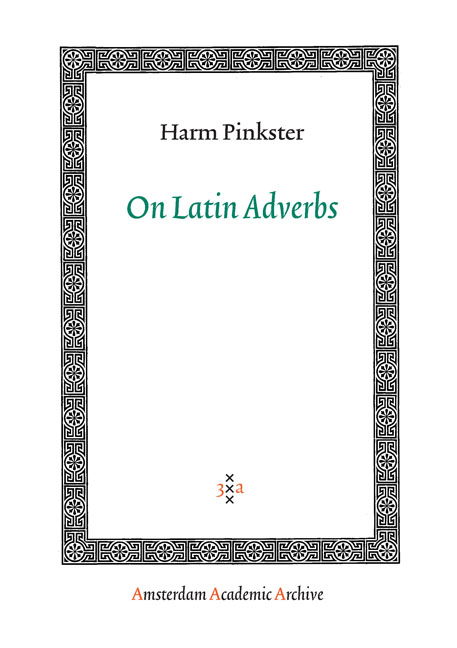Book contents
- Frontmatter
- Preface to this Edition
- Preface
- Contents
- Introduction
- 1 General Problems of Studying a Dead Language
- 2 Problems of Classification
- 3 Adverbs in Roman Grammatical Theory
- 4 The Adverb in Latin Linguistics
- 5 Adverbs as Derived Forms
- 6 Syntactic Problems
- 7 Subclassification of Adverbs
- 8 Adverbs and other Invariables
- 9 The Relationship Between Adverbs and Prepositions
- 10 Adverbs and Connectors
- 11 Adverbs and Subordinators
- Bibliography
- Indices
- Index Auctorum
- Titles Published in the Aaa Series
11 - Adverbs and Subordinators
Published online by Cambridge University Press: 24 January 2021
- Frontmatter
- Preface to this Edition
- Preface
- Contents
- Introduction
- 1 General Problems of Studying a Dead Language
- 2 Problems of Classification
- 3 Adverbs in Roman Grammatical Theory
- 4 The Adverb in Latin Linguistics
- 5 Adverbs as Derived Forms
- 6 Syntactic Problems
- 7 Subclassification of Adverbs
- 8 Adverbs and other Invariables
- 9 The Relationship Between Adverbs and Prepositions
- 10 Adverbs and Connectors
- 11 Adverbs and Subordinators
- Bibliography
- Indices
- Index Auctorum
- Titles Published in the Aaa Series
Summary
This chapter has to be viewed on the one hand as a supplement to what has been said about connectors (ch. 10), intended to bring this class of words out in full relief. On the other hand, I will contend at the end of this chapter that at least some so-called subordinating conjunctions resemble adverbs, and could be described as relative adverbs, having a function within the clause that is comparable with the function of other adverbs elsewhere. I will use the term ‘subordinator’ instead of ‘subordinating conjunction’ throughout.
As far as connectors are concerned, I have tried to show in ch. 10 that syntactic distinctions between connectors and adverbs have been neglected in favour of semantic similarities. This is done even more so with respect to the relationship between connectors and subordinators. Subordinators, coordinators and connectors have been regarded as one part of speech from antiquity onwards (cf. 3.2.; Kiihner-Holzweissig 1912: 254; Blatt 1952: 33) in spite of the obvious syntactic fact that subordinators can be used in hypotactic constructions only.
Their, in many respects, identical treatment was (and is) believed - with more or less reservation - to find support in two connected considerations, which are both open to criticism and comment: (i) the historical relationship between adverbs, connectors and subordinators; (ii) the supposed comparatively recent emergence of the complex sentence, especially the hypotactic type. It is problably due to the diachronic preoccupation of Latin grammars that the precise. relationship between parataxis and hypotaxis has not been clearly realized. I now want first to give a survey of the various types of relationships that are possible between sentences and between clauses, next discuss the position of most Latin grammars with respect to these facts and, thirdly, add a few remarks of my own about hypotaxis and subordinators.
Types of connection between sentences and clauses
I will first briefly deal with the semantic relationship between (the content of) sentences. Clauses will be discussed in the next paragraph. The semantic relationship between sentences may become clear in three ways, either implicitly from the intrinsic relationship of two or more sentences without connecting words and phrases (1) or explicitly by means of demonstrative (deictic) words (2) or connectors (3). Since the problem does not concern specifically Latin alone, I give English examples. For the explicit connecting devices I will add Latin translations.
- Type
- Chapter
- Information
- On Latin Adverbs , pp. 165 - 178Publisher: Amsterdam University PressPrint publication year: 2005

